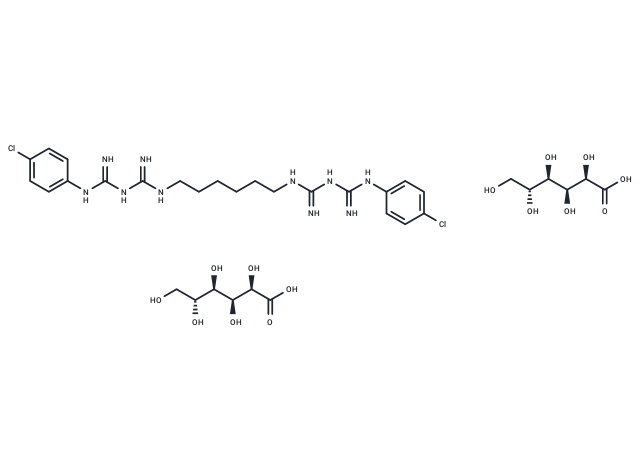Shopping Cart
- Remove All
 Your shopping cart is currently empty
Your shopping cart is currently empty

Chlorhexidine digluconate is a broad-spectrum antiseptic and disinfectant with broad-spectrum antimicrobial activity, inhibits both Gram-positive and Gram-negative bacteria, induces necrosis and apoptosis, and can be used in the study of bacterial infections.

| Pack Size | Price | Availability | Quantity |
|---|---|---|---|
| 500 mg | Inquiry | In Stock | |
| 1 g | Inquiry | In Stock | |
| 5 g | $40 | In Stock |
| Description | Chlorhexidine digluconate is a broad-spectrum antiseptic and disinfectant with broad-spectrum antimicrobial activity, inhibits both Gram-positive and Gram-negative bacteria, induces necrosis and apoptosis, and can be used in the study of bacterial infections. |
| In vitro | Chlorhexidine digluconate exhibits dose-dependent and time-dependent effects on Chinese hamster ovary (CHO) cells (P < 0.05). As the concentration of Chlorhexidine digluconate increases, the mode of cell death shifts from apoptosis to necrosis: Chlorhexidine digluconate (0.00005%, 0.0001%, 0.0005%; 1 hour) induces approximately 1.62%, 5.51%, and 5.47% apoptosis, while the percentages of cell necrosis are 2.38%, 8.62%, and 22.50%, respectively.[1]. |
| In vivo | Compared to mice in group D receiving only saline lavage, a single intraperitoneal injection of Chlorhexidine gluconate (0.05%, 0.025%) significantly reduces the incidence of intra-abdominal abscess formation after lavage surgery. There is no significant difference in the incidence of gross adhesions between groups of mice that have or have not undergone surgery[2]. |
| Molecular Weight | 897.76 |
| Formula | C34H54Cl2N10O14 |
| Cas No. | 18472-51-0 |
| Smiles | ClC(C=C1)=CC=C1NC(NC(NCCCCCCNC(NC(NC2=CC=C(C=C2)Cl)=N)=N)=N)=N.OC[C@@H](O)[C@@H](O)[C@H](O)[C@@H](O)C(O)=O.OC[C@@H](O)[C@@H](O)[C@H](O)[C@@H](O)C(O)=O |
| Relative Density. | 1.06g/mLat 25°C(lit.) |
| Storage | Powder: -20°C for 3 years | In solvent: -80°C for 1 year | Shipping with blue ice. | |||||||||||||||||||||||||||||||||||
| Solubility Information | DMSO: 30 mg/mL (33.42 mM), Sonication is recommended. H2O: 80 mg/mL (89.11 mM), Sonication is recommended. | |||||||||||||||||||||||||||||||||||
Solution Preparation Table | ||||||||||||||||||||||||||||||||||||
DMSO/H2O
H2O
| ||||||||||||||||||||||||||||||||||||

Copyright © 2015-2025 TargetMol Chemicals Inc. All Rights Reserved.